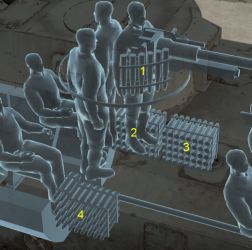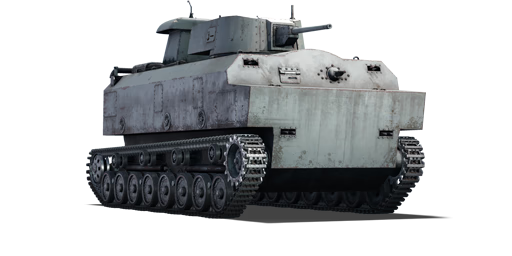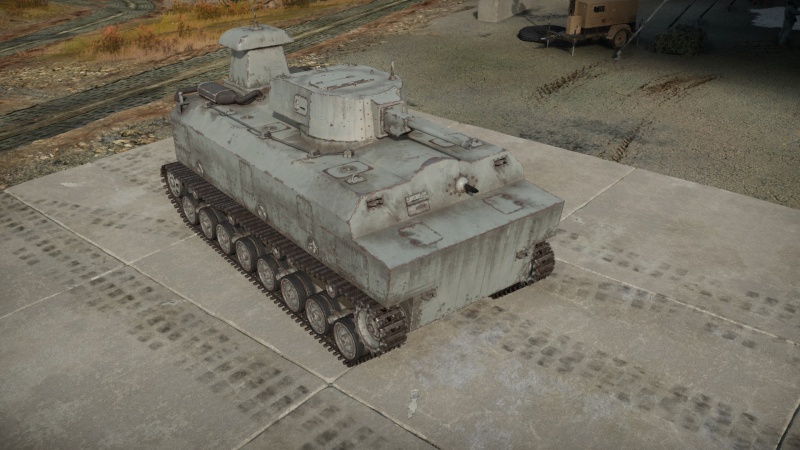Ka-Chi
Contents
Description
The Type 3 Ka-Chi is a premium gift rank I Japanese medium tank with a battle rating of 2.0 (AB/RB/SB). It was introduced during Update "Red Skies" as a reward for the 2021 Summer Landing event.
This vehicle might seem familiar to some Japanese players as this is essentially a waterborne Chi-He, boasting the same turret, max armour of 50 mm, and the same engine.
General info
Survivability and armour
At a first glimpse, the armour might look unappealing and weak sides but if one takes a literal dive in the armour profile it will become apparent that the tank isn't built like a conventional tank but as a submarine. It has a light hull and a pressure hull which both are 10 mm with air in-between, which can protect the tank from depths up to 100 m and tank cannons alike, even withstanding low-end HEAT rounds.
The frontal armour of the Ka-Chi will look very similar to that of the Chi-He maxing out at 50 mm, which with installed pontoons will become even better with spaced armour to boot, defeating most HEAT & HE rounds, and stopping most AP shells as it loses most velocity before it reaches the frontal hull.
The unconventional armour profile of this tank including the plenty of spaced-out crew makes for a very survivable landship of a tank and shouldn't be messed around with.
Armour type:
- Rolled homogeneous armour
| Armour | Front (Slope angle) | Sides | Rear | Roof |
|---|---|---|---|---|
| Hull | 50 mm (17°) Front plate 10 mm (85°) Front glacis 50 mm (9°) Joint plate 25 mm (54°) Lower glacis |
10 + 10 mm | 10 mm 20 mm Bulkhead |
10 mm |
| Turret | 25 + 25 mm (10°) Turret front 50 mm (0-10°) Gun mantlet |
25 mm (10°) | 25 mm Turret rear 50 mm (0-57°) Machine gun port |
12 mm |
Notes:
- Tracks and suspension wheels are 20 mm thick.
- Front of turret has bolted on 25 mm armour to total up to 50 mm thick as the rest of the front.
- The hull is built like a submarine, having an outer light hull and a pressure hull both 10 mm thick.
Mobility
| Game Mode | Max Speed (km/h) | Weight (tons) | Engine power (horsepower) | Power-to-weight ratio (hp/ton) | |||
|---|---|---|---|---|---|---|---|
| Forward | Reverse | Stock | Upgraded | Stock | Upgraded | ||
| Arcade | 40 | 19 | 26.5 | 372 | 458 | 14.04 | 17.28 |
| Realistic | 36 | 17 | 212 | 240 | 8 | 9.06 | |
While this tank might share the same engine as the Chi-He, it still is larger and heavier, resulting in less power-to-weight ratio and worse acceleration. with the big and bulky profile, it still can keep up with the slower medium and heavy tanks of its BR. climbing hills and getting around corners will be slightly tougher than the average tank especially with pontoons installed.
Once pontoons are installed, the Ka-Chi sports 2,300 kg additional weight resulting in worse mobility. It makes the amphibious Ka-Chi an even larger target than before, becoming the largest tank in the game in both length and height. The driver's view is completely obscured by pontoons.
The Ka-Chi is amphibious regardless of whether pontoons are installed or not, these are for making the tank seaworthy. The Ka-Chi by itself already floats and can cross bodies of water.
Modifications and economy
Armaments
Main armament
Comparatively to other light and medium tanks at this battle rating, the 47 mm Type 1 gun is quite surprising with 77 mm of penetration at point-blank range and has a good reload speed. Plus, this fires APHE shells, which deal great post-penetration damage. Comparatively, the 45 mm 20-K gun on Soviet tanks at ranks 1 and 2 has only 62 mm of penetration in similar conditions.
When the pontoons are installed, the cannon's maximum depression angle is reduced by 3°, making it harder to target close enemies in front of you.
| 47 mm Type 1 | Turret rotation speed (°/s) | Reloading rate (seconds) | |||||||||||
|---|---|---|---|---|---|---|---|---|---|---|---|---|---|
| Mode | Capacity | Vertical | Horizontal | Stabilizer | Stock | Upgraded | Full | Expert | Aced | Stock | Full | Expert | Aced |
| Arcade | 120 | -10°/+24° | ±180° | Shoulder | 14.3 | 19.8 | 24.0 | 26.5 | 28.2 | 4.29 | 3.80 | 3.50 | 3.30 |
| Realistic | 8.9 | 10.5 | 12.7 | 14.1 | 15.0 | ||||||||
Ammunition
| Penetration statistics | |||||||
|---|---|---|---|---|---|---|---|
| Ammunition | Type of warhead |
Penetration @ 0° Angle of Attack (mm) | |||||
| 10 m | 100 m | 500 m | 1,000 m | 1,500 m | 2,000 m | ||
| Type 1 APHE | APHE | 77 | 75 | 67 | 58 | 50 | 44 |
| Shell details | |||||||||
|---|---|---|---|---|---|---|---|---|---|
| Ammunition | Type of warhead |
Velocity (m/s) |
Projectile Mass (kg) |
Fuse delay (m) |
Fuse sensitivity (mm) |
Explosive Mass (TNT equivalent) (g) |
Ricochet | ||
| 0% | 50% | 100% | |||||||
| Type 1 APHE | APHE | 808 | 1.49 | 1.2 | 9 | 22.4 | 47° | 60° | 65° |
Ammo racks

| Full ammo |
1st rack empty |
2nd rack empty |
3rd rack empty |
4th rack empty |
Visual discrepancy |
|---|---|---|---|---|---|
| 120 | 115 (+5) | 75 (+45) | 35 (+85) | 1 (+119) | No |
Notes:
- Shells are modeled individually in rack n°1 and disappear after having been shot or loaded.
- As they are modeled by sets of 2, shells from racks 2 to 4 disappear from the rack only after you fire both shells in the set.
Machine guns
The only usable machine gun mounted in the Ka-Chi is the hull machine gun which, once pontoons are installed, is disabled. Only once the hull is uninstalled it can be utilized to very limited extents, as it has a narrow arc of firing, small clip size and only fires rifle-calibre bullets, just good enough to deal with trucks and exposed crews.
It is discouraged to pull off the pontoons just for the machine gun.
| 7.7 mm Type 97 | ||||
|---|---|---|---|---|
| Mount | Capacity (Belt) | Fire rate | Vertical | Horizontal |
| Hull | 4,000 (20) | 499 | ±5° | ±7° |
Usage in battles
When downtiered, the tank can survive most enemy shells at its BR. The surprisingly good armour and the good survivability make it a heavy tank. Its 47 mm gun won't have any trouble to penetrate the enemy armour at its BR. The Ka-Chi's armour is thick, but also flat: angling gives the tank a higher chance to bounce shells.
When uptiered it should play as a support tank. Because some enemy guns can penetrate the armour of the Ka-Chi without trouble (even when angled). The 47 mm cannon will also begin to struggle to penetrate enemy tanks.
In mixed ground battles, there is a high chance that planes will see you due to its large size. So do not go into open fields or large areas. The ability to swim is not a big advantage but on some maps you can use it to flank the enemy.
Pros and cons
Pros:
- Relatively strong frontal armour
- Amphibious vehicle
- Very capable 47 mm Type 1 cannon
- Cannon is shoulder stabilized being stable up to 12 km/h and slightly jittering off-target beyond said speed.
- Submarine like side hull construction works as spaced armour, defeating low end HEAT and HE
- large spacious crew, with 7 crew members being very survivable
- Once pontoons are installed:
- Counts as additional spaced armour for the front and back armour
- Gets a large commander cupola on the turret which doesn't connect to the turret as the hatch is closed, resulting in a fake weak spot
Cons:
- Very large target
- Overall thin armour on side and back only going up to 20 mm
- 3 out of 7 crews were packed close together in the turret, all of them can be potentially knocked out in a single shot
- Worse mobility when equipped with pontoons
- Pontoons reduces its gun depression to only 5 degrees
History
With the success of the Navy's Type 2 Special Motorboat Ka-Mi, a more ambitious project for a bigger, more advanced vehicle was forwarded. Called the Type 3 Special Motorboat, it was not only meant as a fully ocean-going boat, but capable of traveling underwater, although as cargo on the back of a submarine. To withstand the depths (reported as deep as 100 m / 330 ft), the primary pressure hull was a cylinder between 2.0 and 2.1 m (6 ft 7 in) in diameter. Most of the machinery was taken from the Type 1 Chi-He medium tank, presumably to save costs. Like the Ka-Mi, removable sea-going fore and aft pontoons were part of the design, however they were not required to be amphibious. Navigation was accomplished by rudders attached to the rear pontoon, but also the vehicle-mounted twin screws could be independently controlled to maintain a level of steering without the rudders. Nineteen units were reportedly built and extensively and successfully tested, but never used in combat.
Media
Excellent additions to the article would be video guides, screenshots from the game, and photos.
See also
External links
| Japan medium tanks | |
|---|---|
| Type 97 | Chi-Ha · Chi-Ha Kai · Chi-Ha Kai TD · Chi-Ha Short Gun |
| Type 1 | Chi-He · Chi-He (5th Regiment) · Ho-I |
| Type 3 | Chi-Nu · Chi-Nu II |
| Type 4 | Chi-To · Chi-To Late |
| Type 5 | Chi-Ri II |
| Type 61 MBT | ST-A1* · ST-A2* · ST-A3* · Type 61 |
| Type 74 MBT | ST-B2* · Type 74 (C) · Type 74 (E) · Type 74 (F) · Type 74 (G) |
| Type 90 MBT | Type 90 · Type 90 (B) · Type 90 (B) "Fuji" |
| Type 10 MBT | TKX (P)* · TKX* · Type 10 |
| Other | Ka-Chi |
| USA | ▅M4A3 (76) W · ▅M47 |
| *Prototype | |
| Japan premium ground vehicles | |
|---|---|
| Light tanks | Ha-Go Commander · Type 16 (FPS) |
| Medium tanks | Chi-Ha Short Gun · Chi-He (5th Regiment) · Ka-Chi · Chi-Nu II · Type 74 (G) · Type 90 (B) "Fuji" |
| Heavy tanks | Ro-Go · ▅Heavy Tank No.6 |
| Tank destroyers | Ho-Ri Prototype · Type 75 MLRS |





